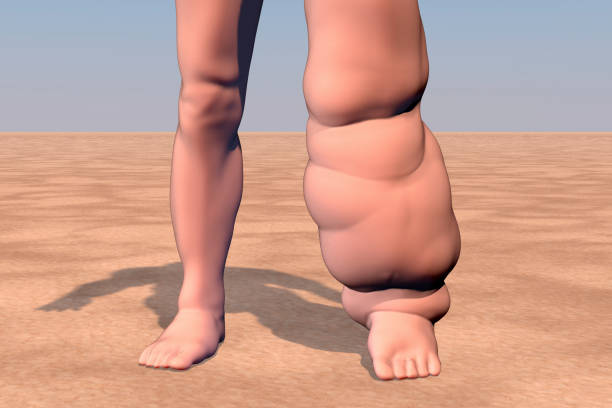Tuesday, February 14, 2023
Elephantomycosis results in a chronic condition of swelling of the skin, especially of the legs and arms, and enlargement of the subcutaneous tissue due to persistent blockage of the lymphatic vessels. In this article, learn about the causes of elephantiasis, and can its symptoms be treated?
What is it elephantiasis?
Elephantiasis or lymphatic filariasis is a parasitic disease spread by helminths, which can spread from person to person through mosquito bites, and the latter is more prevalent in tropical and subtropical regions of Asia, Africa, Southeast Asia, the western Pacific and parts From the Caribbean and South America, where it affects lymphatic filariasis More than 120 million people.
People who live for long periods of time in tropical or subtropical areas are often exposed to infection as a result of the spread of the disease, as exposure to the bites of infected mosquitoes causes over several months to years of lymphatic filariasis.
Previously, it was believed that elephantiasis only affected adults, but it may affect people of all ages, and it can appear in both men and women.
symptoms elephantiasis
1. Swelling of the limbs and genitals
Among the most common symptoms is swelling of body parts, often:
- legs
- the arms
- the chest
- genitals
Not only will these body parts begin to look swollen, but they will appear lumpy with hard, hard skin. Men can develop a hydrocele or swelling of the scrotum.
2. Itching and skin changes
When infected with elephantiasis, the skin is affected to become dry, thick, sore and darker than usual. Some people may experience additional symptoms including fever and chills.
3. Discomfort and pain
The legs, especially the lower legs, are among the most commonly affected areas, as swelling and enlargement can lead to pain and movement problems.
Elephantomycosis can affect the immune system, which may increase the risk of secondary infections.
What is the worm that causes elephantiasis?
The main cause of elephantiasis are microscopic worms. These adult worms live only in the human lymphatic system, which maintains fluid balance in the body and fights infections. Lymphatic filariasis is transmitted from person to person by mosquitoes.
Reasons elephantiasis
1. Mosquito-borne transmission
Elephantomyelia is caused by parasitic worms that are transmitted through mosquito bites. Parasitic worms are divided into three types, including the following:
- Honorary Bancroftian
- Malay brugia
- Brugia Timuri
These worms affect the body’s lymphatic system, which is responsible for removing waste and toxins from the body.
2. Lymphatic filariasis
Lymphatic filariasis, which is spread by mosquitoes, is caused by a nematode that attacks the subcutaneous tissue and lymph vessels of the filariasis type.
Complications of elephantiasis
Elephantomycosis is associated with many physical and psychological complications, including:
disability
Severe swelling and enlargement of body parts leads to a range of effects, including difficulty moving affected body parts, which hinders daily tasks.
Secondary infections
Both bacterial and fungal infections can spread to patients with elephantiasis, as a result of damage to the lymphatic system, resulting in chronic sores in the infected part.
Psychological effects
The appearance of swelling caused by lymphatic filariasis can cause anxiety about appearance in sufferers, resulting in depression and anxiety.
Also read: Lyme disease and co-infection: What you need to know
Treating elephantiasis
after Perform a physical examination or blood tests to diagnose infection in a blood smear by microscopic examination. The infection causing lymphatic filariasis (microfilariae) circulates in the blood at night, so blood collection must take place at night to coincide with the appearance of microfilariae.
After that, the treatment that takes place is determined by:
- Using antifungal medications to kill the worms causing the disease and prevent them from spreading.
- Good cleaning and sterilization of the affected area.
- Use an antibacterial or antifungal cream or ointment.
- Exercise as directed by your doctor.
- Resorting to surgery in extreme cases that require restoration of the affected area or removal of infected lymphatic tissue.
- Make sure to raise the swollen arms and legs when lying down or sitting.
- Wear appropriate shoes in case of swollen feet.
Treatment may also include psychological and emotional support for the patient.
Prevention of elephantiasis
To prevent filariasis, it is important to avoid the bites of mosquitoes that carry microscopic parasitic worms. This type of mosquito usually bites between the hours of dusk and dawn. If you live in an area with lymphatic filariasis, you should sleep in an air-conditioned room, wear long sleeves and pants, and use mosquito repellent on exposed skin at night.
In some areas of the world where lymphatic filariasis is common, the World Health Organization recommends that these areas be treated with preventive chemotherapy. With this preventative strategy, people at high risk of transmission take an annual dose of certain chemotherapy drugs.
Medications have little effect on adult worms but can prevent smaller worms from reproducing. They can also prevent parasites from spreading to mosquitoes.
Frequently asked questions that may interest you
Can elephant disease be cured?
Elephantomycosis cannot be completely cured, but its symptoms can be alleviated and controlled by taking medications prescribed by a doctor, and these medications can kill a small number of the microscopic worms that cause the disease.
Swelling and decreased function of the lymphatic system makes it difficult to fight off germs and infections, so people with the disease will develop more bacterial infections in the skin as well as in the lymphatic system.
How is elephantiasis transmitted?
Lymphatic filariasis is transmitted by infection with filarial parasites, which are worms that live only in the human lymphatic system, and the disease spreads from person to person through mosquito bites.
Then the infected mosquito bites another person, the microscopic worms pass from the mosquito through the skin, to then move to grow in the lymphatic vessels. Adult worms survive for up to 7 years.
Also read: Tinea versicolor: an infection that causes white patches of skin to appear







